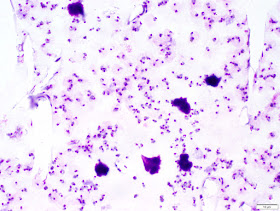A patient with recent travel to southern Africa presented with fever and myalgias. The following are representative views from Giemsa-stained thick and thin peripheral blood films.
Identification?
Any thoughts on the percentage of parasitemia?
What should the laboratory do when seeing this?




Babesia spp.
ReplyDeleteAny other epidemiologic data (place of residence in US? travel history in US? is the patient immune-suppressed? splenectomy? h/o tick bite? evidence of other tick-borne infection?). Presence of multiply-infected RBCs (tetrad form), tight ring forms and overwhelming infection suggest babesia. I would not expect a malaria patient with this high parasitemia to survive, but with babesia immediate treatment with atovaquone/azithromycin or clindamycin/quinine and possible exchange transfusion could be curative.
ReplyDeleteMalaria...a lot of parasites on those slides, not much (falcipa)rum for any more! :-P
ReplyDeleteSeriously though, high parasitemia P. falciparum. I am not going to calculate % parasitemia because math is evil and I hate doing it, but I will give pointers for those who will:
a. count multiply-infected RBCs as '1'.
b. don't count gametocytes (no worries here). Gametocytes are a dead-end stage in the human host and also some anti-malarial drugs are not gametocidal (esp. with P. falciparum).
Plasmodium falciparum
ReplyDelete- P falciparum.
ReplyDelete- 50.3% -- I'm a pathologist and my mantra is "I never take off my shoes" i.e. never count to over 10. When harassed into counting something I usually pick a prime number but they never get the joke.
- call a responsible adult immediately. Are there any other critical values in parasitology?
Plasmodium falciparum with high parasitaemia (ca. 20 %), as some of my predecessors have indicated. Exchange transfusion may be considere.
ReplyDeleteNice pics.
Luis
Agree with P falcip with %parasitemia in the urgent intervention zone: well over 10%. Look at glucose, LFTs, CNS for evidence of systemic organ failure. Would set up for exchange transfusion assuming things will go South with that extent of parasitemia.
ReplyDeleteThis is a serious case of P.falciparum. First, the ring forms trophozoites are the only stage present. Second, the rings are smaller than half of the diameter of the infected red cells. Third, there are multiple rings inside some red cells. Fourth, head phones and "applique" forms are also present.
ReplyDeleteFifth, red cells of various sizes are infected, this shows no predilection for reticulocytes nor older red cells. And last, a very high percentage of infected red cells.
All clues point toward an infection with P. falciparum. I would leave the therapeutic approach as well as the selection of further testing to an infectious disease physician.
Florida Fan
Malaria (P falciparum because of fine chromatin dots? and multiple infection of RBC??), 25%, definitely call the primary team so they can weigh different therapeutic options
ReplyDeletePlasmodium, I would say falciparum, because the size of the rings, ando also the multiple parasitation of some eritrocites. I cant calculate a percentage of infection couse i didnt study how yet. But a good idea is to keep taking samples of blood so you can find "banana shape" gametocites. Laboratory should look for biomarkers of sistemic injury (anemia, renal failure), because falciparum is the most agressive paludism.
ReplyDeletePlasmodium falciparum with high parasitemia .size of the Ring forms .... Ring form of with double chromatin dots , accole forms ...are all seen
ReplyDeleteI agree with the diagnosis of babesiosis that was first proposed. Parasitaemia is too high for Plasmodium falciparum with such mild symptoms and I do not see gametocytes in the form of bananas. Where does the lemalade live in the United States? Was he bitten by ticks?
ReplyDeleteAnnick M.
P.falciparum. App.17,000 parasites / 1 mcl. Not Babesia: no extraerythrocytic parasites, no polymorphism of parasite in RBCs (only monomorphic rings are seen), all rings are quite large in proportion to RBC size than Babesia spp. Endemic region for malaria is in the scenario.
ReplyDeleteSorry, wrong count. 300,000 parasites/1 mcL. Over 5% (heavy infestation, severe prognosis). Urgent reporting with immediate treatment requited.
ReplyDeletePlasmodium falciparum
ReplyDeletePlasmodium falciparum. Parassitemia: circa il 40 % .
ReplyDeleteCarlo
Hyperparasitemia (my quick calculation was around 16%) from plasmodium falciparum.
ReplyDeleteThe laboratory should call the treating team immediately.
This necessitates IV treatment with quinidine gluconate IV till parasitemia is less than 1%. If this fails to reduce in 48 hours, then in the USA it's time to call the CDC and get your artesunate.
Exchange transfusion isn't favored in today's parasite clinical clime.
Nice applique form in the last slide.
ReplyDeletePlasmodium falciparum! No doubt! Accolé forms, polyparasitism, infested red blood cells have “normal” size, uniform image of ring-shaped trophozoites, sometimes with double chromatine dots...
ReplyDeleteI hate counting, but a quick glance gave 25-30%. More than one troph in a red blood cell will count as one if we use a thin film for parasitemia determination. Lab should inform treating doctor without delay! Patient needs immediate hospitalization and close follow-up as this should be considered as a “severe falciparum malaria” (>10% parasitemia).
For treatment, I would refer to e.g. WHO guidelines: https://www.ncbi.nlm.nih.gov/books/NBK294445/#!po=0.500000